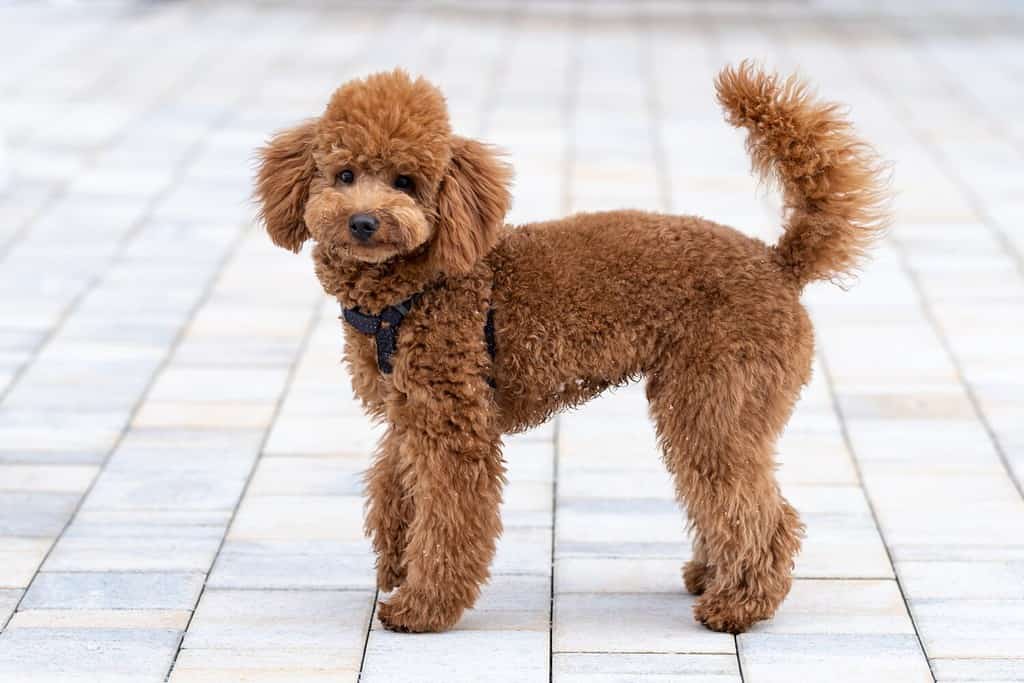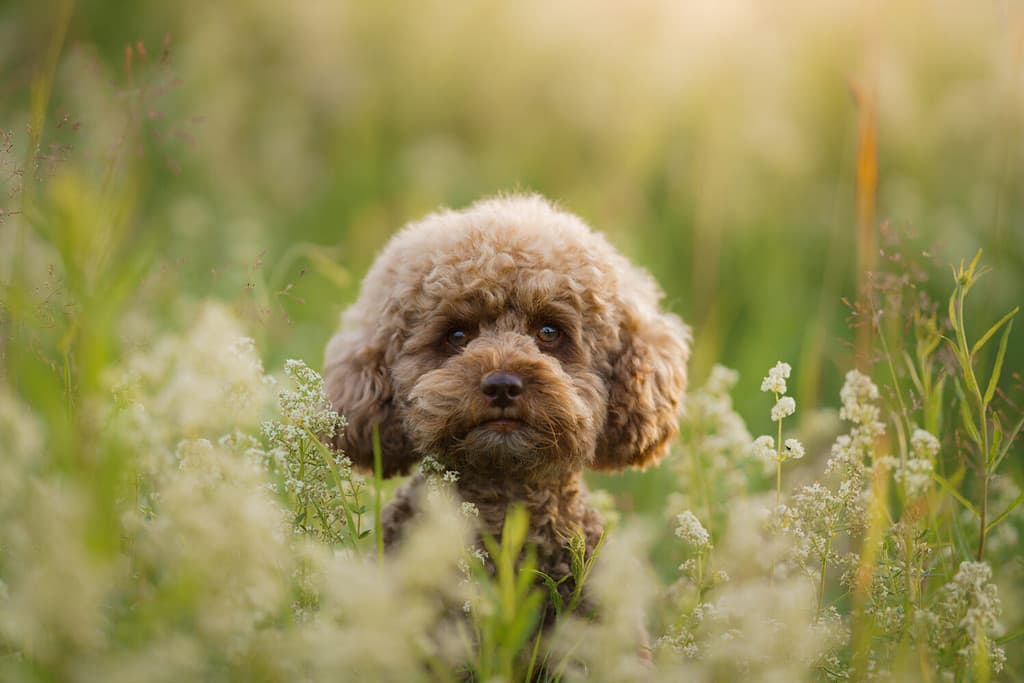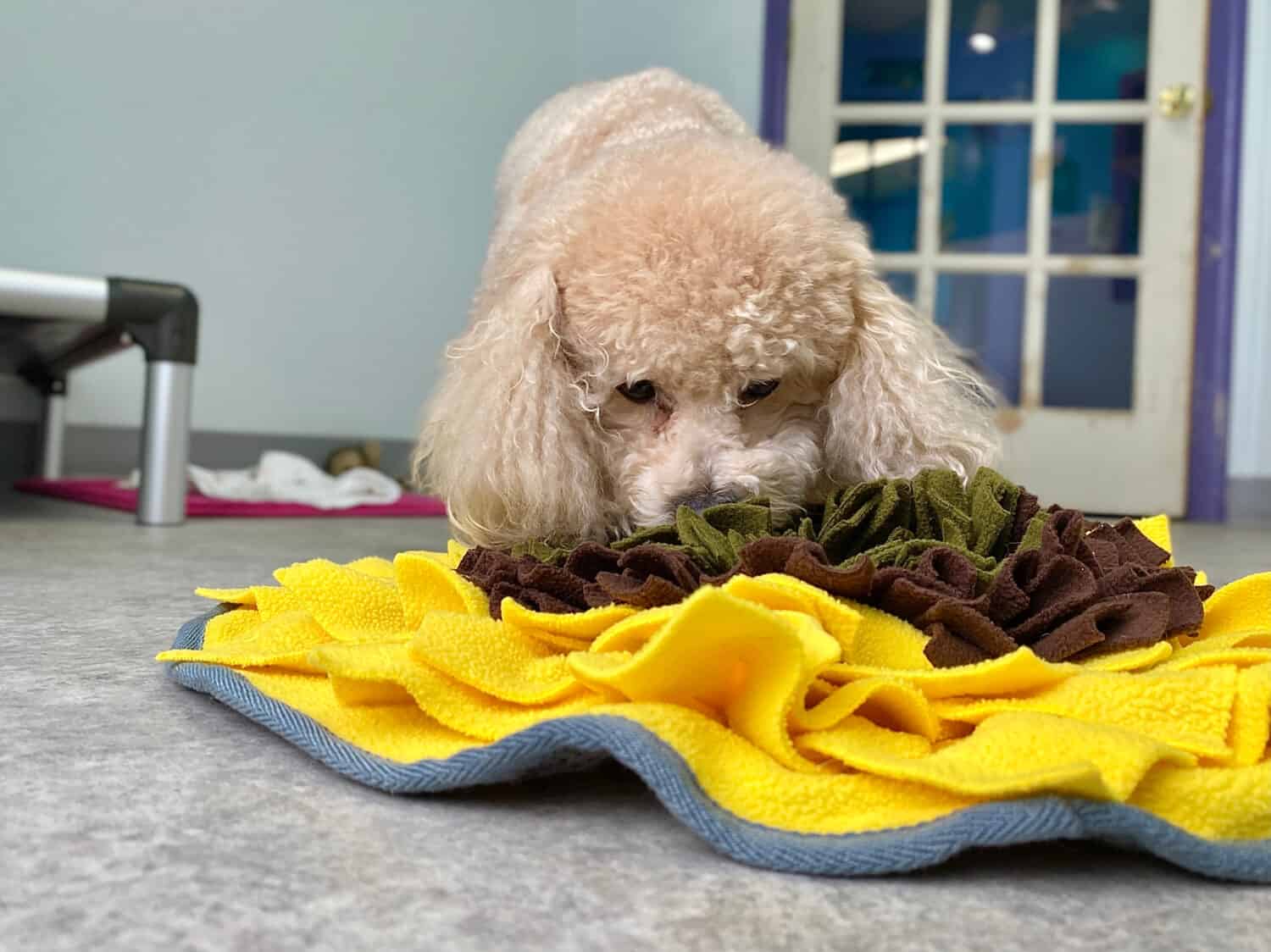Miniature Poodle Summary
Miniature poodles are small, intelligent dogs with curly, low-shedding coats. They are known for their friendly and playful nature, making them excellent family pets. However, regular grooming is essential to maintaining their coat, which can take up a lot of time. These dogs usually live quite long, too – up to 15 years in some cases.
Miniature Poodle Growth and Weight Chart by Age
These dogs vary in their growth. However, they generally follow this pattern:
| Age | Average Weight |
|---|---|
| Birth | 4 – 8 ounces |
| 3 Weeks | Around a pound |
| 8 Weeks | 2 – 3 pounds |
| 12 Weeks | 3 – 5 pounds |
| 16 Weeks | 4.5 – 7 pounds |
| 24 Weeks | 6 – 10 pounds |
| 1 year | 1 – 15 pounds |
When Will My Miniature Poodle Stop Growing?
Miniature poodles typically reach their full height by around one year of age. However, they may continue to fill out and gain muscle mass until they are approximately 18 months old. The exact timing can vary from one dog to another, and factors like genetics and nutrition.
It’s important to note that height and weight may slow down or stop, but dogs often continue to develop mentally for several more months. Therefore, just because your dog is fully grown doesn’t mean they will “act” like an adult.
The table above should help you check your dog’s growth, but you should always contact your vet if you have any questions, as dogs do vary quite a bit.
How Big Will My Miniature Poodle Be When It’s Fully Grown?
The size of a fully-grown miniature poodle will vary somewhat. However, they usually reach a height between 10 to 15 inches at the shoulder. Once they reach their full size, they should weigh around 10 to 15 pounds, too.
However, some dogs may be slightly bigger or smaller. It really depends on their genetics and diet.
Of course, it isn’t odd for some poodles to fall outside of this range, either.
When Should My Miniature Poodle Be Spayed or Neutered?
The ideal time to spay (for females) or neuter (for males) a Miniature Poodle can vary depending on various factors. There is also some debate, even amongst vets, so you may hear several answers.
Many recommend spaying or neutering your dog as early as possible, often before 6 months. This early surgery helps prevent accidental pregnancy and some cancers and may help you avoid certain behavioral problems.
Some vets prefer to wait until a dog is done growing, though, as the hormones are thought to help with certain growth issues. Often, this is around one year for miniature poodles. Delaying the procedure until after the growth phase may be recommended to allow the dog’s bones and joints to develop fully, potentially reducing the risk of certain orthopedic problems.
Of course, certain dogs may benefit from one option over the other. Therefore, you may want to consult with your vet, as well as weighing the pros and cons for yourself.
When Should My Miniature Poodle Be House Broken?
When you first bring your dog home, you should start housebreaking them. However, when this process is over will vary from dog to dog. Some dogs learn very fast, especially if you stay home with them for several weeks and take them out every few hours. If you must work, then your dog will likely take longer to learn.
Either way, start as soon as you bring your dog home. It’s best to start the habit of going outside early instead of trying to break the habit of accidents later. Consistency is key. For every successful potty trip, your dog is one step closer to using the bathroom properly. Always praise and reward your dog when they use the bathroom properly.
Pay attention to your puppy’s behavior. If they start sniffing around, circling, or whining, it may be a sign that they need to go outside. Crate training can be a very helpful tool, as well. Dogs don’t like to soil in their living space, so if they’re in a crate, they may “hold it” until you take them outside.
Crate training is recommended, anyway, as it can make recovery from surgery and travel much easier and less stressful.
Of course, accidents will happen, though they should become less common over time. If you notice an accident, you should be sure to take your dog outside right away. However, don’t punish your dog for it, as this may only make your dog hide when they need to go out.
You can expect your dog to make gradual progress as they slowly gain bladder control and figure out when they need to go. Patience is very important, especially because some dogs make progress faster than others. As smaller dogs, miniature poodles usually take longer to learn, as their bladders are smaller.
When Should My Miniature Poodle Stop Eating Puppy Food?
You should stop feeding your miniature poodle puppy food as soon as they are done growing. Usually, this is around 9 to 12 months. Once they reach their full height, they no longer need the extra nutrition from puppy food. Continuing with their puppy food can result in obesity, which may cause a range of health problems.
Your vet can offer personalized advice for your dog, letting you know exactly when they are done growing. Miniature poodles often mature faster than larger breeds, so they need to switch to adult food sooner.
Switch your dog slowly to adult food. Changes that are too fast can cause digestive problems. Therefore, it’s important to switch them gradually. Do so over the course of a week or longer if your dog shows signs of digestive issues.
Of course, be sure to use high-quality adult food to ensure your dog continues receiving quality nutrition.
When Should I Start Training My Miniature Poodle?
You should start training your miniature poodle as soon as they walk into your home. Usually, this is around 8 to 12 weeks. While dogs may learn fairly slowly at this age, it’s important to get them used to the concept of training and obedience. Puppies learn a lot at this young age, and it’s important for them to start learning the right things early.
Start with basic obedience commands like “sit,” “stay,” “come,” and “down.” Keep training sessions short, positive, and frequent, focusing on one command at a time. It’s much better to do two short sessions a day than one long session a week.
Socialization is vital. Expose your dog to many people, places, and experiences from an early age. Socialization is probably the most important thing you’ll do for your puppy, as it’s absolutely necessary to prevent fearfulness later.
As we’ve stated, start housebreaking your dog right away. It’s best to avoid developing bad habits by letting your dog go in the house.
Introduce crate training to provide your puppy with a safe and comfortable space while also helping with housebreaking and preventing destructive behavior. Puppies can get into lots things. If you can’t supervise them, having a crate available is important.
Get your Miniature Poodle used to a leash and collar early on. Start with short, positive walks around your home and gradually venture outside. Let your dog sniff and wear the leash around the house so that they get used to the feeling.
Use positive reinforcement techniques, including treats and praise. These dogs are very obedient, so training is often pretty easy. They respond well, but they still need practice. Be consistent in your training and commands, and make sure everyone in the household is following the same training.
While your puppy requires training in very specific things, your miniature poodle will need to be trained throughout their whole life. This process helps reinforce what they’re learning. You can also move on to more advanced commands. However, because poodles are very smart, training is vital for mental stimulation. Otherwise, your dog can get bored fairly quickly.
What Cues Should I Teach My Miniature Poodle First?
Teaching your miniature poodle fundamental commands should be where their training starts. Many basic commands are necessary for more advanced commands, and basic commands are often the easiest to learn.
Start with “sit,” which is easily the most fundamental command. It’s helpful in many situations and is utilized when teaching other commands. Move onto “stay,” “come,” and “down” once your dog has understood the concept of sit and does so with some reliability.
“Leave it” is a harder command to teach, but it is necessary for a dog’s safety. It prevents your dog from eating things they shouldn’t and can be utilized to reach good behavior, too. Once you teach it, you can use it to teach your dog to leave anything alone.
“Heel” teaches your dog to walk nicely on a leash without pulling. It’s the last basic command you should teach and should come after basic leash training.
When Will My Miniature Poodle Calm Down?
Miniature poodles often don’t mature completely mentally until around 3 to 4 years old. Therefore, you can expect your dog to be quite active and needy before this stage.
That said, these dogs are very energetic and intelligent. Therefore, they require a lot of exercise and mental stimulation to stay happy and healthy. Without it, they can become destructive and hyperactive. While these dogs are small and fluffy, they are not your average toy dog.
Of course, these dogs also vary in their energy levels. Some are very energetic, and others may not be. If your dog is exceptionally hyperactive or exhibits behavioral issues, consider consulting a professional dog trainer or a veterinarian for guidance on managing their behavior.
Common Health Issues Your Miniature Poodle Might Experience
Miniature poodles are susceptible just like any other canine. Not every dog will experience these problems. However, it’s essential for owners to be aware of common health issues. Regular vet checkups can also be helpful in diagnosing these problems early, which often helps with treatment.
- Hip Dysplasia: This is a genetic condition where the hip joint doesn’t fit into the hip socket correctly. It can lead to pain and arthritis. It is partially genetic but can also be linked to diet and overexercising.
- Eye Problems: Like many dogs, miniature poodles can get several eye conditions, including cataracts, PRA, and glaucoma.
- Allergies: Like many dogs, skin and food allergies are common. Check your dog regularly for skin allergies, itching, and ear infections.
- Patellar Luxation: This is a condition where the kneecap dislocates from its normal position. It often requires surgery to fix and may even cause lameness in some situations.
- Dental Issues: Because miniature poodles have such small mouths, they are prone to dental issues. Therefore, getting them regular dental checkups (and maybe even professional cleanings) on top of the usual tooth brushing is important.
Pictures of Miniature Poodle as Puppies

Miniature poodles are very small when they are young. However, they grow very quickly.
©zulkarnisezer/Shutterstock.com
Pictures of Miniature Poodles at 6 Months

At 6 months, these dogs are almost fully grown. Therefore, they look a lot like adults.
©Korneeva Kristina/Shutterstock.com
Pictures of Fully Grown Miniature Poodles

Miniature poodles reach their full size pretty fast, sometimes as early as 9 months.
©dezy/Shutterstock.com
Thank you for reading! Have some feedback for us? Contact the AZ Animals editorial team.








